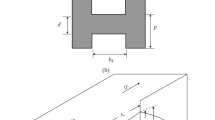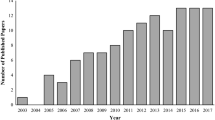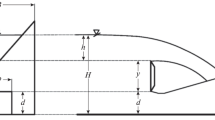Abstract
In this study, a single triangular sharp-crested weir and four combined structures consisting of the weir and rectangular gates with different dimensions were tested to find the effects of water head over the weir (h) and geometric parameters such as gate height (d), gate breadth (b), and the distance between top of the gate and bottom of the weir (y) on discharge coefficient (Cd) under free flow conditions. A new form was proposed for the equation used to compute Cd, which is based on a combination of triangular weir and rectangular gate equations. Experimental results showed that as dimensionless ratios of h/d, h/b, and h/y increased, the discharge coefficient and total discharge increased, too. Additionally, discharge coefficient for the combined weir–gate increased with increasing gate opening at same flow rates. It was concluded that, at low discharges, the gate and its opening are the main water head controllers, while water levels at high discharges are mainly controlled by the weir. The two utilized soft computing models (MLP and SVR) predicted Cd accurately, with R2 values (for total data) of 0.966 and 0.967, respectively. However, MLP was considered superior, due to its better statistical indices of RMSE, MAE, and R2 (0.027, 0.022, and 0.984, respectively) for validation data set compared to those of SVR (0.065, 0.042, and 0.948, respectively). Comparison of results with equations presented in the literature showed that some equations match the observed data much better than others, which are noticeably different. It was concluded that assuming the general form of a gate or a triangular weir equation for a combined weir–gate structure shall be reconsidered before its utilization in particular applications.













Similar content being viewed by others
Abbreviations
- A g :
-
Gate area
- b :
-
Gate width
- b 1 :
-
Weir breadth
- B :
-
Channel width
- C :
-
Regularization cost parameter in SVR
- C d :
-
Discharge coefficient
- d :
-
Gate height
- Fr:
-
Froude numbers
- g :
-
Gravity acceleration
- h :
-
Water head over the weir
- H :
-
Upstream water depth
- h d :
-
Depth of water just downstream the gate
- k :
-
Kernel function in SVR
- N:
-
Number of data set in RMSE and MAE equation
- Q t :
-
Total combined structure discharge
- Re:
-
Reynolds numbers
- v :
-
Fluid velocity
- w ij :
-
Weight of the connection between the jth neuron in a layer with the ith neuron in the previous layer of ANN
- We:
-
Weber numbers
- x i :
-
Value of the ith neuron in the previous layer of ANN
- y :
-
Distance between top of the gate and bottom of the weir
- Y i :
-
Prediction parameter in RMSE and MAE equation (Cd in this study)
- y j :
-
Output from the jth neuron in a given layer of ANN
- ε :
-
Size of error insensitive zone in SVR
- θ :
-
Top angle of the triangular weir
- σ :
-
Surface tension
- ρ :
-
Flow density
- μ :
-
Fluid dynamic viscosity
- γ :
-
Kernel specific parameter in SVR
References
Alhamid AA, Negm AM, Al-Brahim AM (1997) Discharge equation for proposed self-cleaning device. J King Saud Univ 9(1):13–24
Altan-Sakaraya A, Kokpinar MA (2013) Computation of discharge for simultaneous flow over weirs and below gates (H-weirs). J Flow Meas Instrum 29:32–38
Aydin I, Ger AM, Hincal O (2002) Measurement of small discharges in open channels by slit weir. J Hydraul Eng ASCE 128(2):234–237
Aydin I, Altan-Sakarya AB, Sisman C (2011) Discharge formula for rectangular sharp-crested weirs. J Flow Meas Instrum 22:144–151
Balouchi B, Nikoo MR, Adamowski J (2015) Development of expert systems for the prediction of scour depth under live-bed conditions at river confluences: application of different types of ANNs and the M5P model tree. J Appl Soft Comput Elsevier 34:51–59
Bateni SM, Borghei SM, Jeng DS (2007) Neural network and neuro-fuzzy assessments for scour depth around bridge piers. J Artif Intell Elsevier 20:401–414
Bautista-Capetillo C, Robles O, Júnez-Ferreira H, Playán E (2014) Discharge coefficient analysis for triangular sharp-crested weirs using low-speed photographic technique. J Irrig Drain Eng 140(3):06013005
Baylar A, Hanbay D, Batan M (2009) Application of least square support vector machines in the prediction of aeration performance of plunging overfall jets from weirs. J Expert Syst Appl Elsevier 36:8368–8374
Belaud G, Cassan L, Baume J (2012) Contraction and correction coefficients for energy-momentum balance under sluice gates. In: World environmental and water resources congress 2012, pp 2116–2127. https://doi.org/10.1061/9780784412312.212
Bilhan O, Emiroglu ME, Kisi O (2011) Use of artificial neural networks for prediction of discharge coefficient of triangular labyrinth side weir in curved channels. Adv Eng Softw 42:208–214
Bos MG (1989) Discharge measurement structures, 3rd edn. International Institute for Land Reclamation and Improvement, Wageningen
Chanson H, Wang H (2013) Unsteady discharge calibration of a large V-notch weir. J Flow Meas Instrum 29:19–24
El-Saiad AA, Negm AM, Waheed El-Din U (1995) Simultaneous flow over weirs and below gates. Civ Eng Res Mag 17(7):62–71
Emiroghlu ME, Bilhan O, Kisi O (2011) Neural networks for estimation of discharge capacity of triangular labyrinth side-weir located on a straight channel. Expert Syst Appl 38:867–874
French RH (1986) Open-channel hydraulics. McGraw Hill Book Company, New York
Goyal MK, Ojha CSP (2011) Estimation of scour downstream of a ski-jump bucket using support vector and M5 model tree. Water Resour Manag 25:2177–2195
Habibzadeh A, Vatankhah A, Rajaratnam N (2011) Role of energy loss on discharge characteristics of sluice gates. J Hydraul Eng 137(9):1079–1084
Haghiabi AH, Azamathulla HM, Parsaie A (2017) Prediction of head loss on cascade weir using ANN and SVM. ISH J Hydraul Eng 23(1):102–110
Hayawi HAA, Yahia AAA, Hayawi GAA (2008) Free combined flow over a triangular weir and under rectangular gate. Damascus Univ J 24(1):9–22
Homayoon SR, Keshavarzi A, Gazni R (2010) Application of artificial neural network, Kriging, and inverse distance weighting models for estimation of scour depth around bridge pier with bed sill. J Softw Eng Appl 3:944–964
Hong J, Goyal MK, Chiew Y, Chua LHC (2012) Predicting time-dependent pier scour depth with support vector regression. J Hydrol 468–469:241–248. https://doi.org/10.1016/j.jhydrol.2012.08.038
Jahangirzadeh A, Shamshirband S, Aghabozorgi S, Akib S, Basser H, Anuar NB, Kiah MLM (2014) A cooperative expert based support vector regression (Co-ESVR) system to determine collar dimensions around bridge pier. Neurocomput J 140:172–184
Johnson MC (2000) Discharge coefficient analysis for flat-topped and sharp-crested weirs. J Irrig Sci 19(3):133–137
Juma IA, Hussein HH, Al-Sarraj MF (2014) Analysis of hydraulic characteristics for hollow semi-circular weirs using artificial neural networks. Flow Meas Instrum 38:49–53
Kecman V (2001) Learning and soft computing: support vector machines, neural networks and fuzzy logic models. MIT Press, Cambridge
Keshavarzi A, Gazni R, Homayoon SR (2012) Prediction of scouring around an arch-shaped bed sill using Neuro-Fuzzy model. Appl Soft Comput 12:486–493
Khalili Shayan H, Farhoudi J (2013) Effective parameters for calculating discharge coefficient of sluice gates. Flow Meas Instrum 33:96–105
Lee TL, Jeng DS, Zhang GH, Hong JH (2007) Neural network modeling for estimation of scour depth around bridge piers. J of hydrodynamic 19(3):378–386
Lozano D, Mateos L, Merkley G, Clemmens A (2009) Field calibration of submerged sluice gates in irrigation canals. J Irrig Drain Eng 135(6):763–772
Malekmohamadi I, Bazargan-Lari MR, Kerachian R, Nikoo MR, Fallahnia M (2011) Evaluating the efficacy of SVMs, BNs, ANNs and ANFIS in wave height prediction. J Ocean Eng 38:487–497
Martínez J, Reca J, Morillas MT, López JG (2005) Design and calibration of a compound sharp-crested weir. J Hydraul Eng 131(2):112–116
Mohammadpour R, Shaharuddin S, Chang CK, Zakaria NA, Ab Ghani A, Ngai WC (2015) Prediction of water quality index in constructed wetlands using support vector machine. Environ Sci Pollut Res 22(8):6208–6219
Munson BR, Young DF, Okiishi TH (1994) Fundamentals of fluid mechanics, 2nd edn. Wiley, New York
Negm AM (1995) Characteristics of combined flow over weirs and under gate with unequal contractions. In: Proceedings of 2nd international conference on hydro-science and engineering, China, vol 2(A), pp 285–292
Negm AM (2000) Characteristics of simultaneous overflow—submerged underflow: (unequal contractions). Eng Bull 35(1):137–154
Negm AM, El-Saiad AA, Saleh OK (1997) Characteristics of combined flow over weirs and below submerged gates. In: Proceedings of Al-Mansoura engineering 2nd international conference on (MEIC’97) Al-Mansoura, Egypt, vol 3(B), pp 259–272
Negm AM, Albarahim AM, Alhamid AA (2002) Combined free flow over weirs and gate. J Hydraul Res 40(3):359–365
Ozkan F, Kaya T (2010) Using intelligent methods to predict air-demand ratio in venturi weirs. J Adv Eng Softw 41:1073–1079
Pal M, Singh NK, Tiwari NK (2011) Support vector regression based modeling of pier scour using field data. Eng Appl Artif Intell 24(5):911–916
Parsaie A, Haghiabi AH, Saneie M, Torabi H (2017) Predication of discharge coefficient of cylindrical weir-gate using adaptive neuro fuzzy inference systems (ANFIS). Front Struct Civ Eng 11(1):111–122
Qu J, Ramamurthy AS, Tadayon R, Chen Z (2009) Numerical simulation of sharp-crested weir flows. Can J Civ Eng 36(9):1530–1534
Rajaratnam N (1977) Free flow immediately below sluice gates. Proc J Hydraul Div ASCE 103(HY4):345–351
Swamee PK (1988) Generalized rectangular weirs equations. Proc J Hydraul Eng ASCE 114(8):945–949
Swamee PK (1992) Sluice gate discharge equations. Proc J Irrig Drain Eng, ASCE 118(1):57–60
Vapnik VN (1995) The nature of statistical learning theory. Springer, New York
Vapnik VN (1998) Statistical learning theory. Wiley, New York
Acknowledgements
Authors would like to thank Mr. Mehdi Zinivand, Professor Mahmood Shafai-Bajestan, and Dr. Mohammad-Reza Nikoo for their invaluable help, ideas, and comments.
Author information
Authors and Affiliations
Corresponding author
Rights and permissions
About this article
Cite this article
Balouchi, B., Rakhshandehroo, G. Using Physical and Soft Computing Models to Evaluate Discharge Coefficient for Combined Weir–Gate Structures Under Free Flow Conditions. Iran J Sci Technol Trans Civ Eng 42, 427–438 (2018). https://doi.org/10.1007/s40996-018-0117-0
Received:
Accepted:
Published:
Issue Date:
DOI: https://doi.org/10.1007/s40996-018-0117-0




